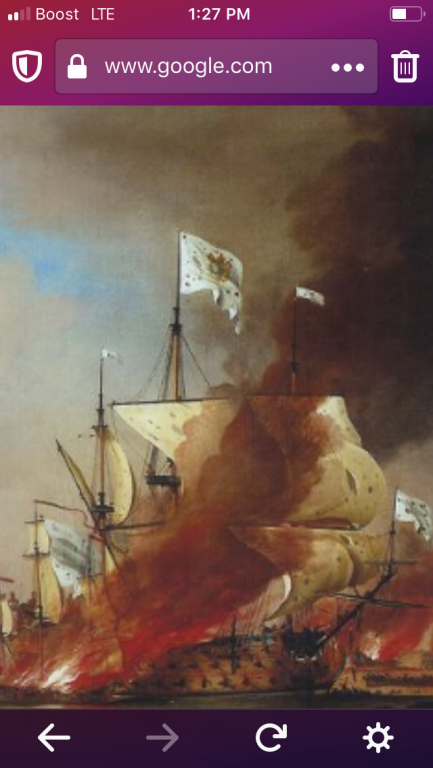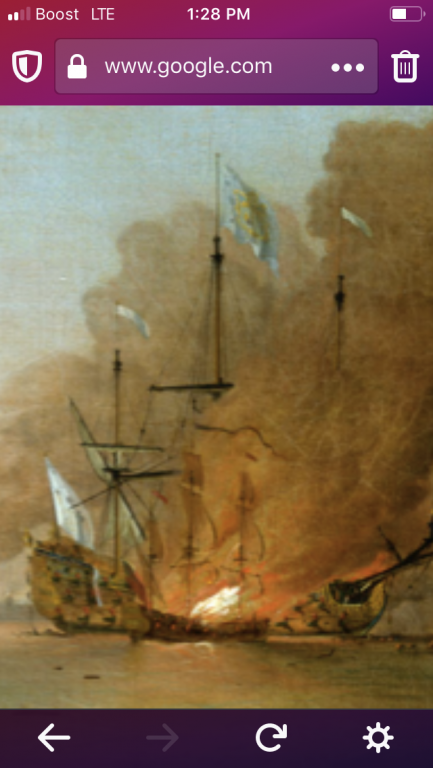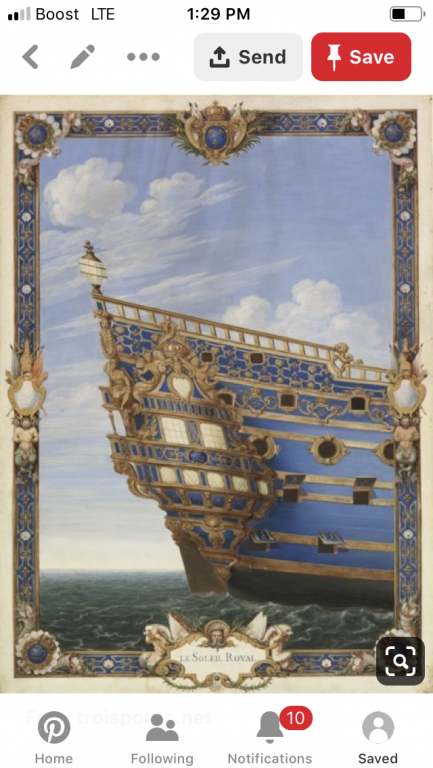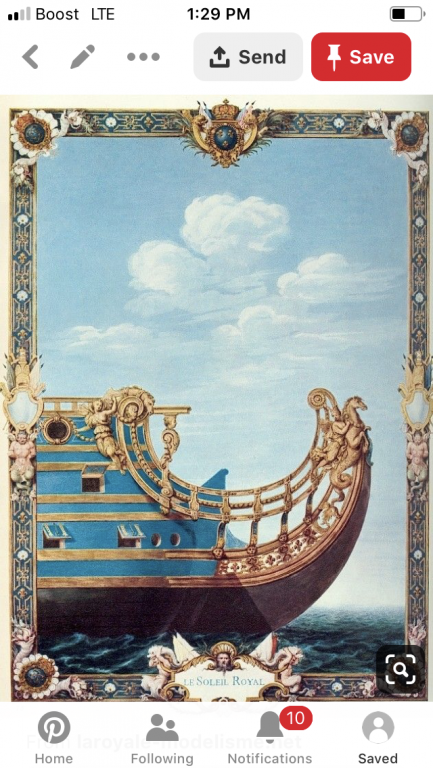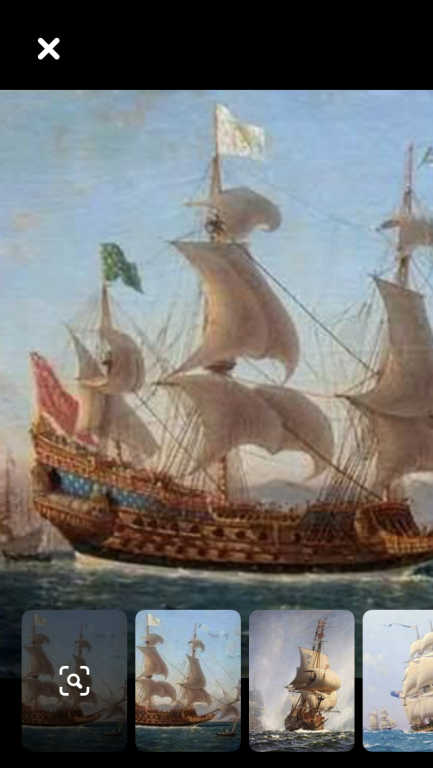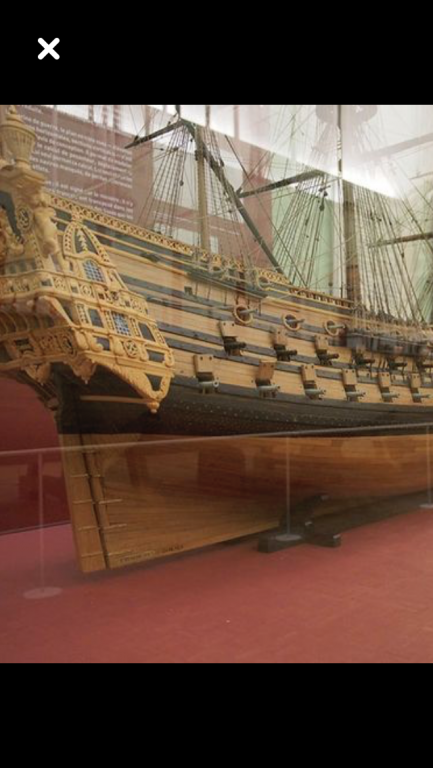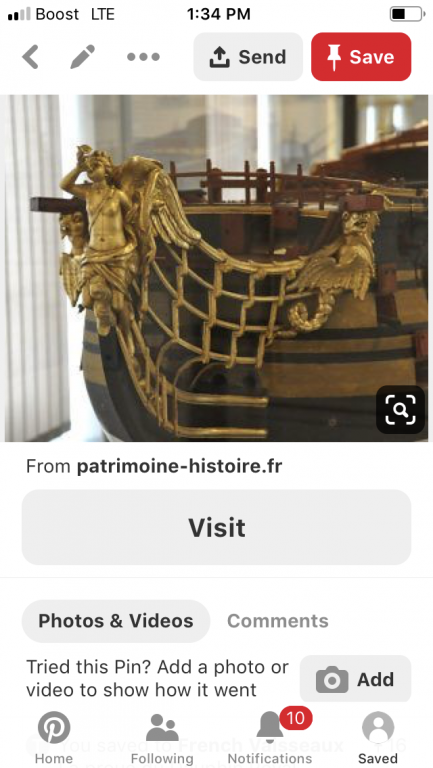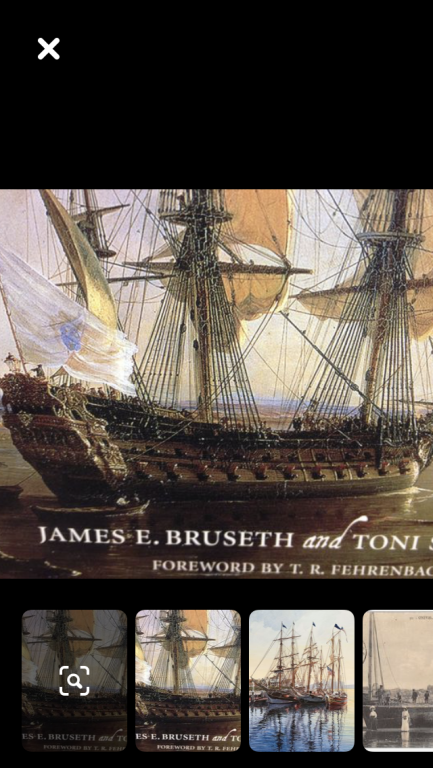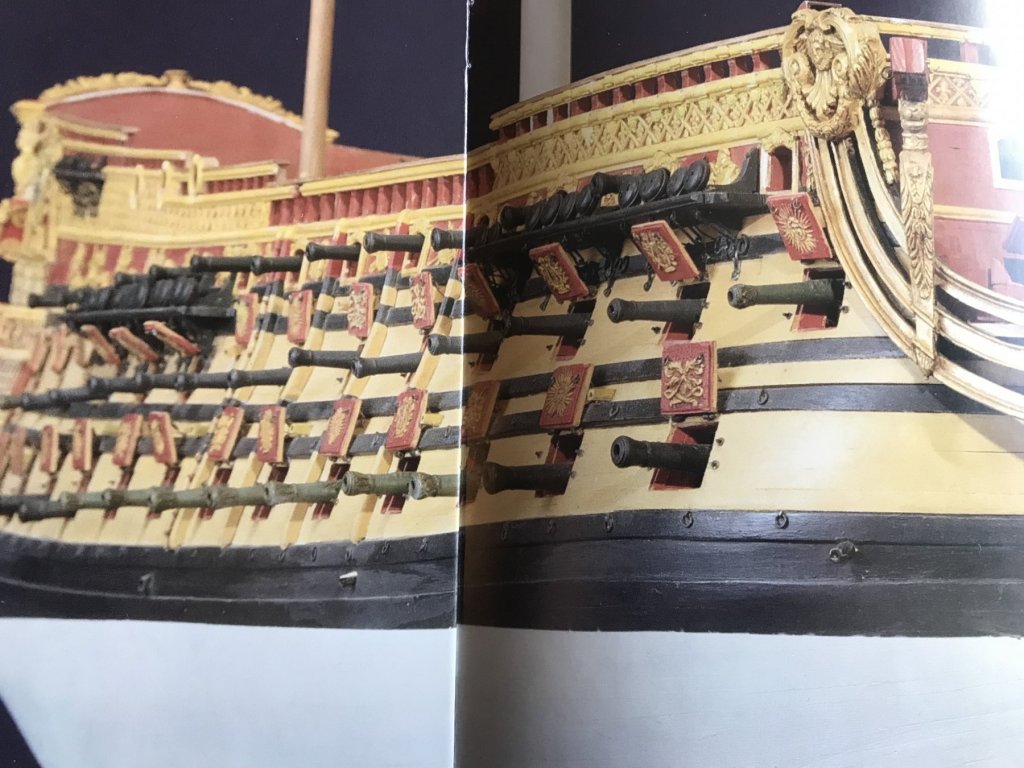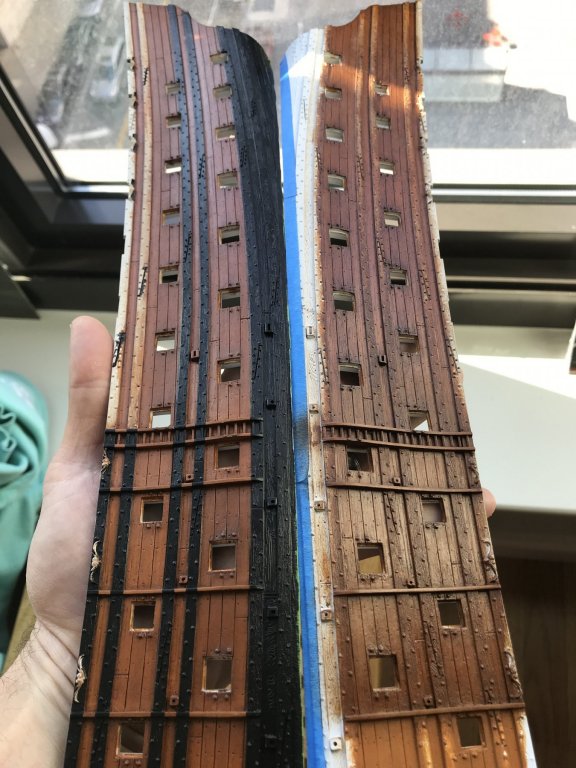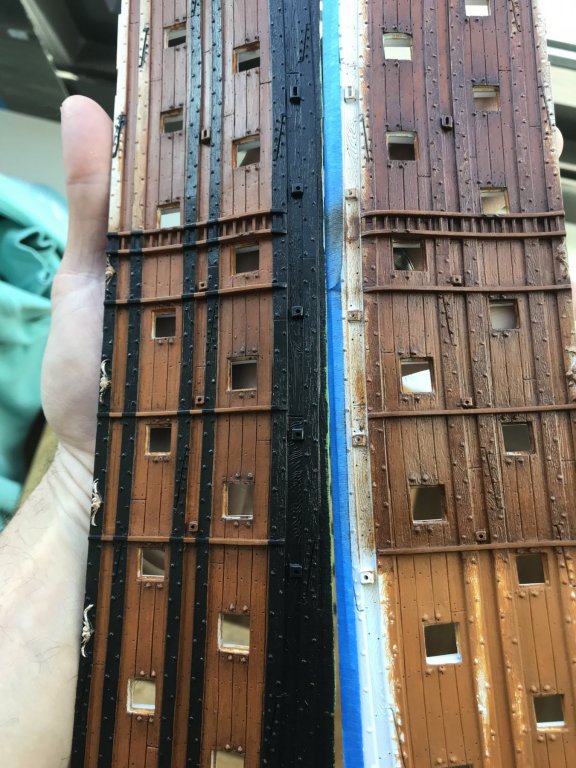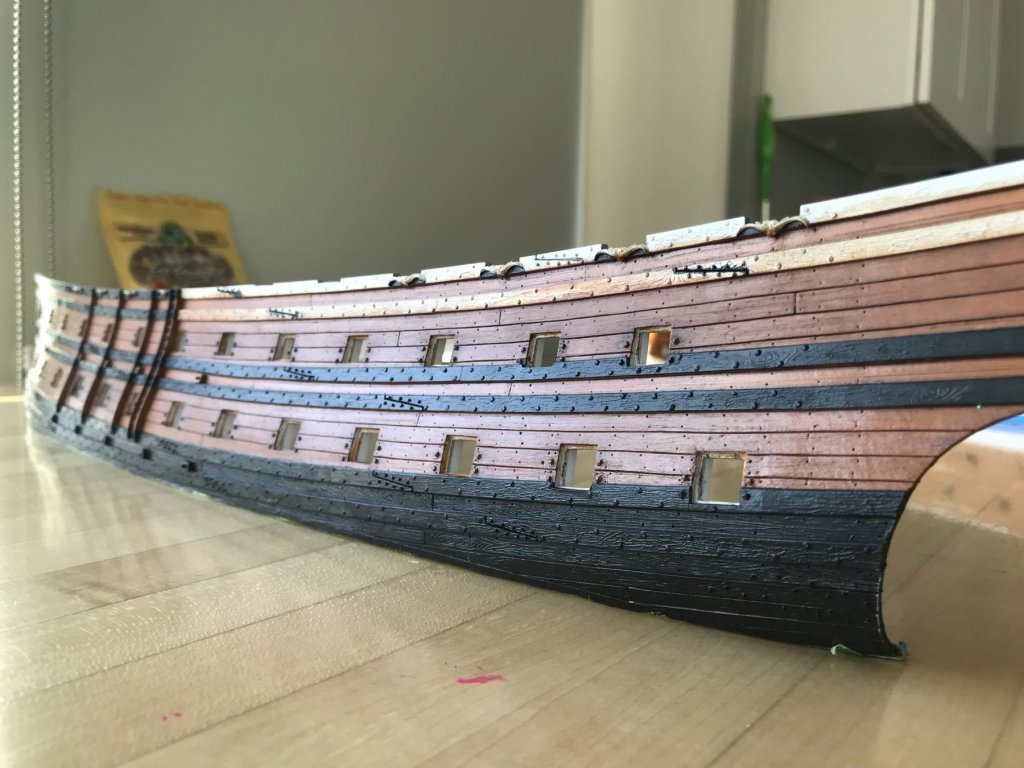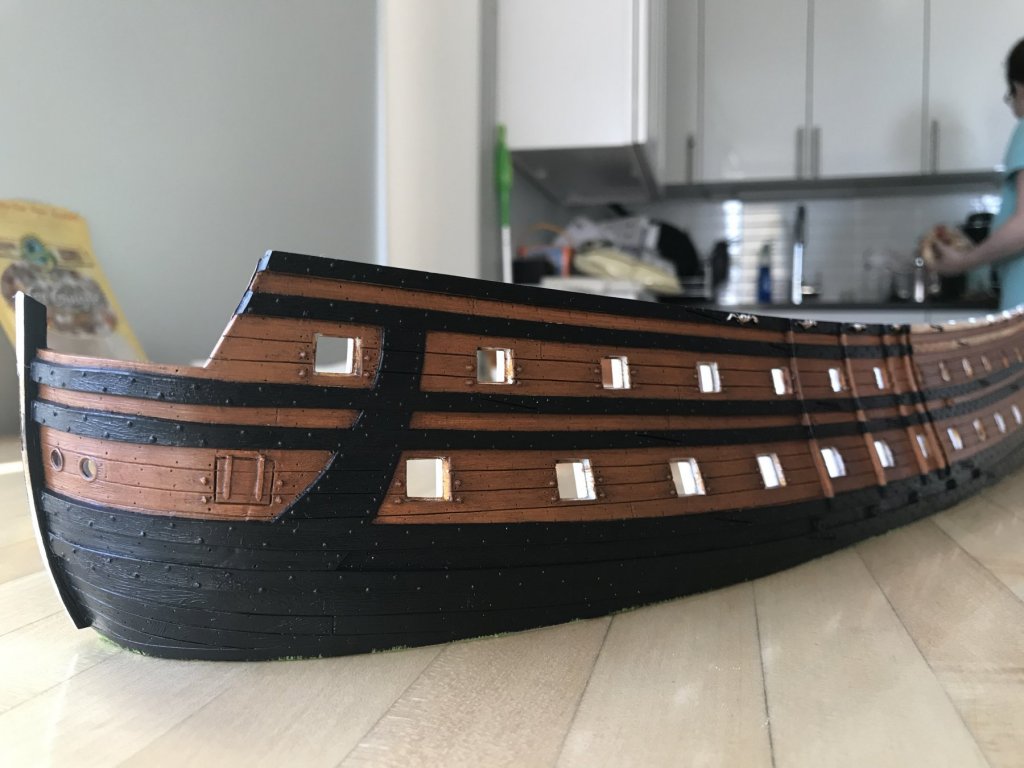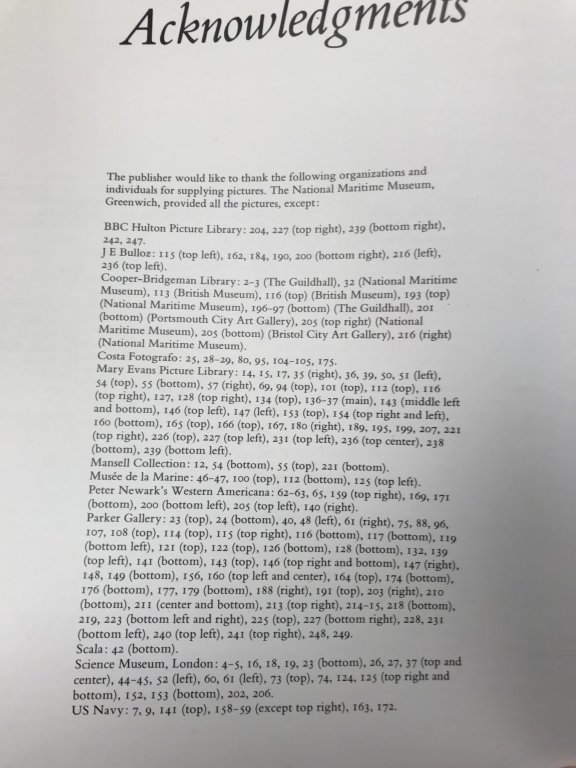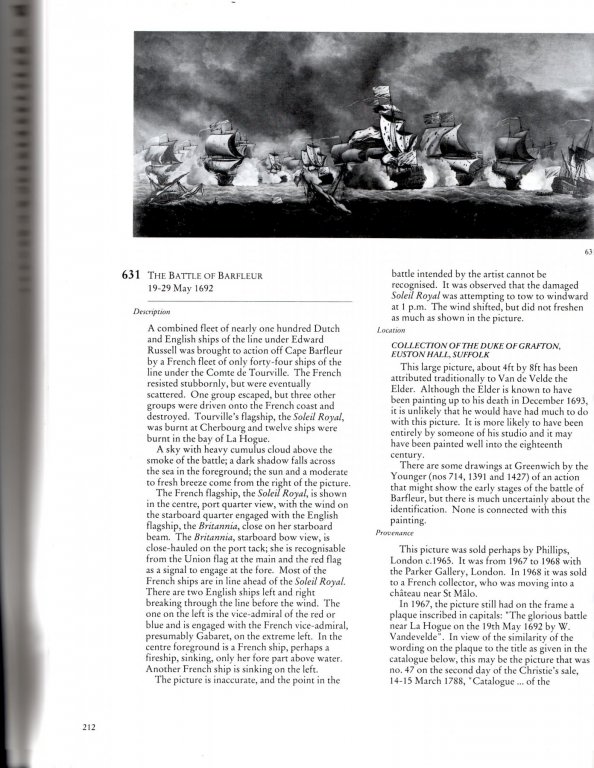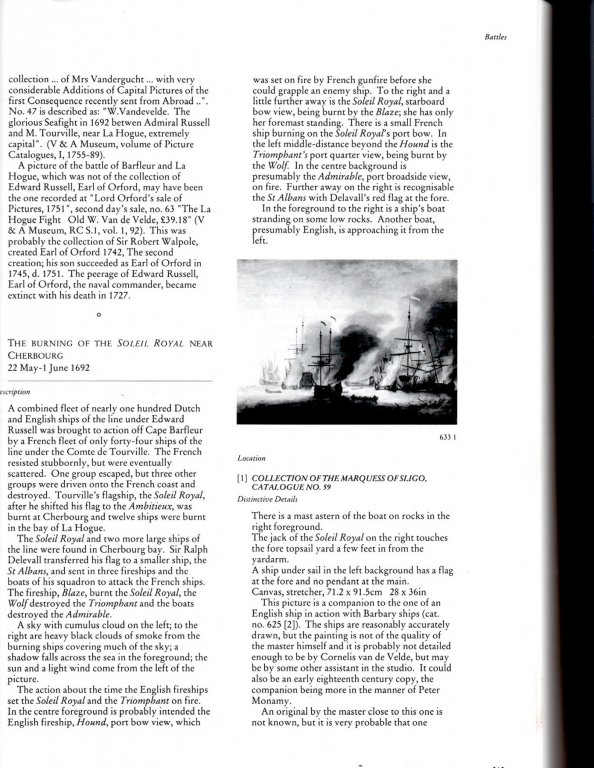-
Posts
3,304 -
Joined
-
Last visited
Content Type
Profiles
Forums
Gallery
Events
Everything posted by Hubac's Historian
-
Like my wife, she’d set you adrift on your 1:48. Maybe a Viking’s funeral, to boot. There’s honor, or something, in that. Pretty sure. Yup.
- 2,699 replies
-
- heller
- soleil royal
-
(and 9 more)
Tagged with:
-
In my opinion, there are four modern, scratch-built models (not including the Tanneron model) of SR that are really fascinating and good. The following is one of them. VISITOR BEWARE: the link comes with a warning that the page is not secure, so keep that in mind. I use Apple products, and am perhaps over-confident in their defenses. http://www.lara.dk/oa_modelskibe/20.html
- 2,699 replies
-
- heller
- soleil royal
-
(and 9 more)
Tagged with:
-
Excellent repair, and beautiful, clean work!
- 510 replies
-
- reale de france
- corel
-
(and 1 more)
Tagged with:
-
Thank you very much BeareG! The VDVs are the gold standard, IMO, especially in an age of relatively poor documentation of the French fleet. It is both tragic and ironic that the French built some of the most spectacularly beautiful ships, and all we are left with are a collection of fragmentary relics that give some sense of their grandeur. Along those lines, Bakhuizen’s Barfleur paints a dramatic portrait of SR, even if there are massive incongruities between the portrayal of this supreme three-decker and her reality; chief among them, is that Bakhuizen grafted the two-tiered stern of a second-rate onto the hull of a three-decker. Added to that is the fact that the sheer is represented as being much too flat. Nevertheless, it is a fascinating portrait. Incidentally, this painting was also the inspiration for the particular shade of gold that I chose for the model. Bakhuizen’s SR literally glows with a warm golden hue. I found an acrylic that very much gives this same impression of pure gold gilding. I’ve applied a little to the port side, upper main wale, where there are a series of main deck port enhancements. It looks great, but the paint is not easy to work with; you have to keep going over it, un-diluted, to get even coverage. Beare, I am interested in the Texel-type paint technique you were describing earlier. Can you post a few pics of that, here?
- 2,699 replies
-
- heller
- soleil royal
-
(and 9 more)
Tagged with:
-
Yes, Dan, and Herbert Tomesan does a good job of representing the brown stuff on his Texel models.
- 2,699 replies
-
- heller
- soleil royal
-
(and 9 more)
Tagged with:
-
Hi Baere Galleon! Thank you for looking in and for your kind words. Well, I’d be hard-pressed to say that blackened wales were an absolute certainty for French ships, at this time in the late 17th C. Somewhere, I’ve read a brief account (that I may be able to locate, later) of the first SR’s colors; this account, as I recall, does at least mention a blackened boot top, above the white of the lower hull. So, there’s that, if I’m remembering correctly. The color P. Vary/E. Compardel (in my opinion) portrait of SR’s reconstructed bow and quarters also shows the blackened boot topping. Everything else about this portrait, in terms of color, seems off to me. I find it highly unlikely that the ship would have been painted entirely in ultra-marine, nor that the wales would be guilded. These two portraits by Peter Monamy agree with the black boot topping, at least: When, exactly, they were painted is not clear, but sometime within 20 years of the event depicted, seems reasonable. This (I think contemporary) portrait of La Couronne, again, shows the black boot, and maybe blackened wales: Here is another (I believe) contemporary portrait of the LaSalle expedition, featuring the second-rate Le Joli. The image distortion has to do with the angle at which I took this cell picture (of a book’s cover), but otherwise, the painting is a very detailed and accurate accounting of a French warship of this period. Wales and bootcap definitely black. Then, we can explore the realm of near-contemporary models and modern, research-based models. The Louis Quinze model, of which I am having trouble up-loading images of, dates to around the turn of the 17th C., and her wales are blackened. This circa 1740s model of Le Dauphin Royal is from a later time than SR1, but definitely shows blackened wales: The modern Frolich model of L’Ambiteaux shows blackened wales: And the recent work of J.C. Lemineur and Jose Tusset show blackened wales on the St. Philippe of 1693: Not to mention the fact that the Tanneron model of SR, although the sources for this model are clouded in mystery, shows blackened wales. It may not have been an absolute doctrine to paint French ship’s wales black, in the late 1680s, but it seems a reasonable convention of the times. Also, I just happen to like how it looks.
- 2,699 replies
-
- heller
- soleil royal
-
(and 9 more)
Tagged with:
-
Thank you, Dan! As the days tick away, I’m beginning to feel less certain about what I will have to say at the conference about paint compatibility, but your point about lacquer topcoats is well received. Maybe the latex really is the way to go, there. The latex and acrylic paint are both water-based, after all. My spray test on the samples didn’t cause any issues - aside from laying it down too heavily. So, anyway, we will see. I look forward to seeing you and everyone in New London.
- 2,699 replies
-
- heller
- soleil royal
-
(and 9 more)
Tagged with:
-
Hi guys! Thank you for the kind words. Heinrich, I will be using a much lighter color for the decks because they should represent raw wood, whereas the hull would have been painted to protect all of the iron fasteners. I’ll use ModelMaster’s Random Tan with the VDB, or maybe the walnut ink for a distress wash. The ModelMaster produces a durable and level finish. Yes, Mark, I’ve been using Grumbacher’s Academy line for the Raw Sienna and the Black. I liked that I wouldn’t have to do any color mixing to arrive at my ventre-de-biche color. The raw sienna has been durable enough, with all the rubbing away of VDB, but the black rubs away pretty easily even after the paint seems well dried. The samples I made months ago seem durable, but maybe the black just needs an extended dry-time. I think, I will spray the whole hull with matte lacquer, once all of the detailing is done. Accidentally, I bought a matte latex-based clear-coat. That leaves a good surface finish. I just wonder whether lacquer would be better/more durable, and whether blushes will form over the acrylic.
- 2,699 replies
-
- heller
- soleil royal
-
(and 9 more)
Tagged with:
-
Beware - the height between decks of the Heller kit is absurdly out of proportion; even allowing for the thickness of deck planking (4”) and the height of deck beams above (approx. 10-12”), there would still be almost 7’ of clear headroom, between decks, if the Heller kit were full-size. This is a problem that Cedric, of the La Reyne conversion project first pointed out. He was/is attempting to correct this flaw, but it requires closing in all of the existing gunports, re-locating the wales, adjusting the sheer of the decks - and even after all of that, you may wind up running into problems with the new positioning of the guns relative to the gradient of the tumblehome. In the end, it may end up looking more wrong than if you just left the decks and guns where they are. For me these problems - if one felt absolutely compelled to fix them - veer off into the slippery slope of whether you should just go ahead and build the model from scratch, so that everything is as it should be. I suspect that may be the reason that we have not heard from Cedric in such a long time; perhaps the compromises he would have to make with regard to accurate representation, in order to work within certain confines of the kit architecture, sapped his interest in the project. Hopefully, not; I still think he can make a very good model of La Reyne without going to extreme lengths. It is very easy, IMO, with these conversion projects to become so bogged down with certain corrections that the project becomes Herculean and not fun, anymore.
- 244 replies
-
- heller
- soleil royal
-
(and 1 more)
Tagged with:
-
Hello Heinrich, I own an airbrush - new in box, single action - but not a compressor. Using an airbrush would certainly have simplified the application of the raw sienna base color, acrylic. By brush, I had to lay down 5 thin coats to get the color saturation I was after, without muddying up the details. Perhaps I will use that airbrush when it comes time to basecoat the upper bulwarks. Air compressors come in much smaller sizes today, than they used to. The trouble has been these artist acrylics; they must be thinned, but then they require a lot of coats. They also seem kind of fragile, until they’ve had a good long time to fully dry and harden. Purpose-made model acrylics, which I also am using, are not as finicky; 1-2 coats, straight out of the bottle, and you are done. The painting of the wales is coming along nicely. It has had the odd, and unexpected effect of somewhat muting the appearance of the VDB distress coat. Before I began blacking in the port side wales, the distressing from port to starboard seemed a near match. Now the port side seems significantly lighter. I will have to wait until after blacking in the starboard wales to make any adjustments. I will probably tone the blacking down with a dullcoat wash, but that will also wait until painting is near complete.
- 2,699 replies
-
- heller
- soleil royal
-
(and 9 more)
Tagged with:
-
Hello Heinrich, She is looking good!! A curiosity - do you have any pictures of the joint between your central bulkhead and the rise of the stern deadwood? As for the upper bulwarks - you will have to, I think, decide whether to cut down the top-most sheer step, in order to conform more closely with the SP’s 3-step sheer. Yes, my M.O. was to add all the detail to the upper bulwarks first. I will, eventually, return to working on them because I would like to make and attach the quarter gallery amortisement, and the rest of the large figurative sculptures before priming and painting. Only after they are painted will I install them to the hull. By then, I will have completed construction up to, and including, the main deck. One advantage of framing and re-constructing the stern is that It is not necessary to clamp the bulwarks in-board, in order to fit within the parameters of the stock stern plate. When I first built this model, years ago, I had to use fishing line, pierced through both sides of the upper bulwarks and concealed by the QGs, to make a twist-caul that brought the upper bulwarks into position; that meant that the whole construction was under tension, and I am frankly amazed that the whole thing has survived all this time, without bursting apart. When the time comes to install the upper bulwarks, I will make styrene bulkhead stanchions that will be concealed by the forecastle deck (and also hidden by the dummy galley stoves), as well as beneath the quarter deck. These bulkhead stanchions will give me something solid to glue to and will also create support for my dummy deck beams, to which I will glue the styrene upper decking. The exact placement of the stoves is still a little up in the air because I haven’t really focused on it yet. They will have to be placed so that the chimneys that pierce the forecastle deck don’t interfere with the guns, the cathead timbers, or egress to and from the deck.
- 244 replies
-
- heller
- soleil royal
-
(and 1 more)
Tagged with:
-
Hi EJ - I’m glad to see progress on RL; she’s coming along nicely. Take this with a grain of salt, please, but it seems as though there are peaks and valleys along the lower planking of the waist, that could do with some filler to level them out. From these pictures, it is hard to say whether that is really happening, or if it is a trick of light and perspective. I don’t mean to be a pain, but I thought it was worth mentioning.
-
I work with a variety of thicknesses of plastic sheet, and laminate, whenever necessary, for thicker scantlings. After “dressing” edges with a sandpaper block, or emory board, the laminations can’t be distinguished - definitely not under the paint, anyway.
- 244 replies
-
- heller
- soleil royal
-
(and 1 more)
Tagged with:
-
I agree with EJ, that wider is definitely better. I don’t think you can go too far wrong in using the spacing of the stock kit stand. I think, whatever your spacing between pedestals, that you will want to first design a pleasing forward pedestal at the appropriate location, then you can design the second pedestal so that the waterline is level. I like all of your base ideas. I think it will look especially sharp to incorporate the frieze grid of fleur-de-lis into the base. As for cutting away the stem, I did glue in the hawser pieces to help stabilize this area before cutting with a hand scroll saw. Is it your plan, after all, to glue solid wood keel, stem and stern post to the bulkhead former?
- 244 replies
-
- heller
- soleil royal
-
(and 1 more)
Tagged with:
-
Well, that looks about right to me, Heinrich. Although, it looks like you still have a stem remnant that still has to be removed. I sincerely doubt that anything of the lower deck will be visible from above, and very little through the gunports. As to the bulkheads - simply spraying them flat black will deaden any light that gets to them, and render them virtually invisible. I’m excited for this project to take off!
- 244 replies
-
- heller
- soleil royal
-
(and 1 more)
Tagged with:
-
I may be mis-remembering this, but before I cut away the lower hull - I was trying to mark a new LWL. I was using a block and a pencil at the new height working aft to forward with the keel down on a flat surface. That’s when I realized that the kit does reflect a deeper draft at the sternpost than the stem - I forget the discrepancy, but something between 2-4 scale feet. My solution was simply to measure up from the moulded waterline, 5/16”, taking into account the extreme curvature of the transom; you can’t simply lay the ruler flat against the hull, here, because the measurement will be fore-shortened, and your waterline will drop in an arc, as you begin to round these extreme curves.
- 244 replies
-
- heller
- soleil royal
-
(and 1 more)
Tagged with:
-
Hi Daniel, I’m a member of the Shipcraft Guild of New York City. Depending upon where you live in Jersey, we are probably not too far from each other. We could always make room for a visitor a future meeting, in Brooklyn. As for the demonstration - spoiler alert - the actual technique is dead-simple and virtually fail-proof. I will be doing samples with two different washes over two different surfaces; the stock raised grain, as well as the grain sanded away so that the coarse-grit scratches become the wood structure/grain. The latter provides the better, more realistic result, IMO, but both are pleasing. There will be pictures I took of Herbert Thomesan’s work on the Texel diorama, as he is the one who taught me this distressing method. Much of the discussion will center on surface prep, paint compatibility issues, and different effects. The 10 minutes allotted, should just about cover what I have to say about it. Maybe one of my club members will record the session on my phone, and I will post it here, afterwards. As of now, I’ve made decent progress with painting the port side; I’ve painted in the bootcap and have begun blacking in the wales; all of my simulated iron work shows nicely under the paint. The starboard side is base-coated and distress washed through the waist, but I have paused the distress washing so that there is a good visual contrast for the Joint Clubs, and to allow the oil paint a chance to cure. So, I will be bringing the model along, even if nothing is assembled.
- 2,699 replies
-
- heller
- soleil royal
-
(and 9 more)
Tagged with:
-
Please don’t ask me the specifics, because I don’t know, but there are environmental regulations that determined what exactly the spray environment needed to be and how they disposed of the excess polyester resin. To bring that portion of the factory up to code was going to be cost prohibitive, at the time, because the company was experiencing a significant dip in sales. If peak production meant that the company was selling 11-12 pianos a week, when I started in ‘05, they were down to 7-8 pianos sold when I left in ‘09. They just weren’t selling enough pianos to support that shift, at the time. I will end this train, here, so that we can get back to talking about Chuck’s model, which really is fabulous. Bravo! I look forward to seeing his work at Joint Clubs next week.
- 1,784 replies
-
- winchelsea
- Syren Ship Model Company
-
(and 1 more)
Tagged with:
-
Hi Bob - excellent finish tutorial. Had to butt-in on the Steinway comment. I was a pattern maker there for a number of years. Steinways are lacquer finished; sprayed in successive coats until there is really quite a thick film. Sprayed pianos go into a temperature controlled drying room for a number of weeks, for the finish to fully cure. The surface is then wet-sanded in successively finer grits until leveled and to a satin sheen. A hand applied compound provides the final soft sheen. Pianos can be ordered with a mirror polish. This is ultimately achieved with compound and a rotary buffer, after the initial sanding. They really lay that lacquer down thick! While I was there, there was a lot of talk about switching to polyester, but it was going to be expensive to get up to NY code, and the finish, when damaged, is not easily repairable. Polyester film also lacks the “feel” of lacquer; it can literally be plastic-y.
- 1,784 replies
-
- winchelsea
- Syren Ship Model Company
-
(and 1 more)
Tagged with:
-
Hello, Jan! There was no caption, but towards the back of the book, there was an acknowledgments page that referenced the Parker Gallery. Now, in an amazing display of promptness, I had an email response from Mr. Archie Parker, this morning. I sent him thumbs and everything else I knew about the portrait, which all came from this citation in the Robinson annotated collection of VDV works: This Robinson citation seemed to reference Euston Hall as the, then (1980, I believe was the publication date for these Robinson volumes), location of the portrait. However, the citation also references Parker Gallery in the late 60’s, and the subsequent sale and ensconcement at St. Malo. Last year, I contacted Euston Hall, but the art director, there, had no idea, or records of the painting ever being in their collection A little later, this afternoon, Mr. Parker wrote back to me to inform me that he had checked Parker Gallery’s records, but unfortunately, their sale records do not stretch back prior to the 1970’s, and they do not appear to have any archival photos of the portrait either. Mr. Parker could not have been more gracious, and he promised to contact me, should the painting surface in the future; he “flagged” me in their system. So, in the meantime, I am back to square one, only with a slightly less grainy image. My next move will be to attempt to track down any art historians, in residence, at St. Malo. This is a significant portrait, in it’s own right (regardless of my personal interest in it), so there is some likelihood that it may have been loaned from private collection, at some point, for public exhibition. Maybe someone has some ideas about that, somewhere. ’Gonna keep digging. Like the actual remains of SR, buried beneath a parking lot at Cherbourg, this painting must be hiding somewhere.
- 2,699 replies
-
- heller
- soleil royal
-
(and 9 more)
Tagged with:
-
My observation of trends in French naval architecture is that the open, lower stern balcony (middle deck level) is an artifact of the early First Marine. Apparently, their (relatively) fragile construction left them open to damage from a strong following sea. By the time of the St. Philippe, this stern balcony would merely be a vestigial “false” balcony, projecting only far enough from the face of the stern to serve as a supporting ledge to the corbels that support the open balcony above, on the main deck level. What is interesting to me, on the other hand, is that Mr. Lemineur has chosen to represent the “balcony” of the quarter deck level, also as a vestigial fascia, as opposed to a shortened balcony that does not wrap to the quarters. The original drawing does suggest as much, but the French loved their balconies, which were also much admired by the English.
- 244 replies
-
- heller
- soleil royal
-
(and 1 more)
Tagged with:
-
Thank you, EJ, I am keeping my fingers crossed. I sent an initial enquiry to the Parker Gallery last night. It turns out they are art dealers and not a museum, but someone there may still have a clue, if even 39 years later. Thank you Heinrich for all of your excellent picture references; you are so good about including them in your posts, and I appreciate them. I have been curious about the Citadel paints for a while, and the staff at the Warhammer shop, here in New York, seem particularly knowledgeable. At some point, when I’m passing through there, I will stop in and ask them their thoughts on ver-de-gris paint effects. As for the full rig, I will pull out all of the stops when I get to the fully visible guns. The guns below deck are mostly concealed, so all of the extra effort to rig them and paint the interiors, etc, seems wasted. I appreciate the quality and effort of Dafi’s build, but most of it, for all intents and purposes, will only exist in pictures, once all of the decks are in. I prefer to spend time detailing what can be seen. Heinrich, you raise many good points regarding the carriages and their wheels. I think that Dafi’s display is probably the most likely and sensible. If navies were to also paint the treads of the wheels, the deck would soon be streaked in red, or yellow, or whatever. So, carriages would be painted, yes I think, but wheels not. The issue as to whether the French would be diligently polishing their bronze, at all times, is a tricky one. Heinrich, again, makes a sound argument for patination because these ships of the Premier Rang Extraordinaire were most often in-active. And as they were moored along the Penfeld (or Rochfort, Toulon, etc) as SR was for the first 18 years of her existence, the French often neglected the basic maintenance required to keep the ships well aired and dry. Consequently, SR was rotten well before her eventual re-build and involvement in any real action. It seems unlikely, though, that SR had her guns actually mounted for very much of those 18 years, as the need to equip other active ships would be more pressing, and there must have been some recognition that the weight of those batteries would be detrimental to the ship, if she were just laid up in ordinary. So, if the guns weren’t blazing from some other ship, they were probably being stored in the arsenal, and being left to the whims of the sea air. My preference is for a light patina, primarily because I think it will make visible these beautifully moulded details, that I would be hard pressed to re-create, at this scale. Also, though, bronze patination, or “rust” is a different animal than iron oxidation. Rusty iron guns are dangerous and in-operable. I don’t exactly know this to be a fact, but it seems unlikely that discoloration of bronze would negatively affect the operation of the guns. Lastly, light ver-de-gris calls attention to the fact that SR's guns were bronze. Much as I think it looks cool, I don’t think I’d go as green as Herbert did on the guns fir his Texel model.
- 2,699 replies
-
- heller
- soleil royal
-
(and 9 more)
Tagged with:
-
Thanks, Dan. They’ll look even better in ver-de-gris patina; all of SR’s guns were bronze. And I’m cautiously optimistic that if I get the green wash right, you’ll even be able to see the tiny fleur-de-lis that are moulded onto the barrels.
- 2,699 replies
-
- heller
- soleil royal
-
(and 9 more)
Tagged with:
About us
Modelshipworld - Advancing Ship Modeling through Research
SSL Secured
Your security is important for us so this Website is SSL-Secured
NRG Mailing Address
Nautical Research Guild
237 South Lincoln Street
Westmont IL, 60559-1917
Model Ship World ® and the MSW logo are Registered Trademarks, and belong to the Nautical Research Guild (United States Patent and Trademark Office: No. 6,929,264 & No. 6,929,274, registered Dec. 20, 2022)
Helpful Links
About the NRG
If you enjoy building ship models that are historically accurate as well as beautiful, then The Nautical Research Guild (NRG) is just right for you.
The Guild is a non-profit educational organization whose mission is to “Advance Ship Modeling Through Research”. We provide support to our members in their efforts to raise the quality of their model ships.
The Nautical Research Guild has published our world-renowned quarterly magazine, The Nautical Research Journal, since 1955. The pages of the Journal are full of articles by accomplished ship modelers who show you how they create those exquisite details on their models, and by maritime historians who show you the correct details to build. The Journal is available in both print and digital editions. Go to the NRG web site (www.thenrg.org) to download a complimentary digital copy of the Journal. The NRG also publishes plan sets, books and compilations of back issues of the Journal and the former Ships in Scale and Model Ship Builder magazines.




